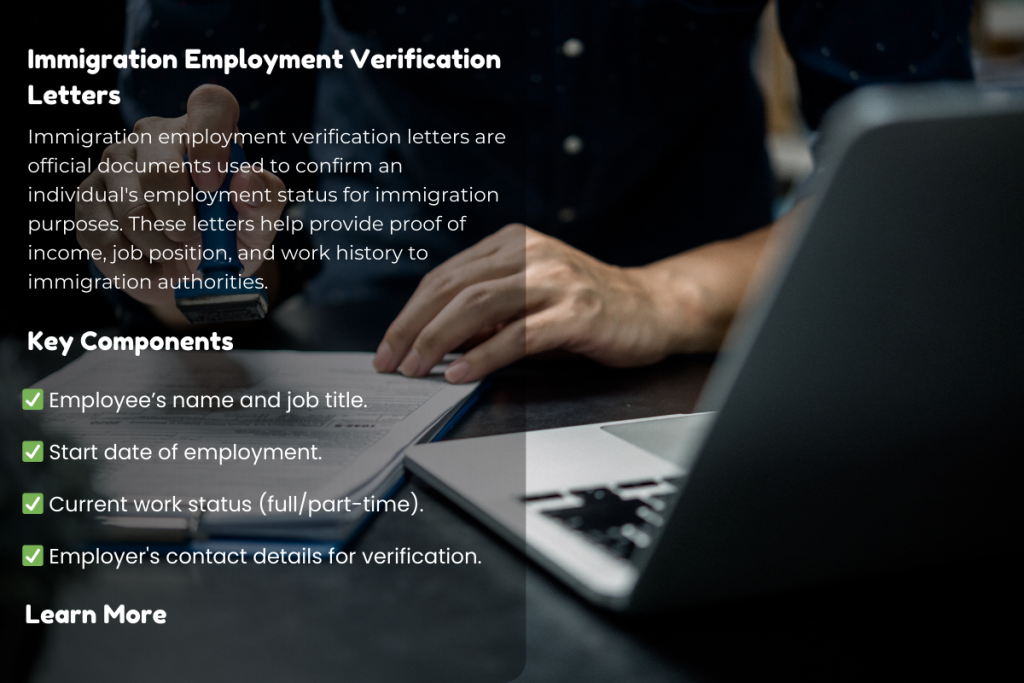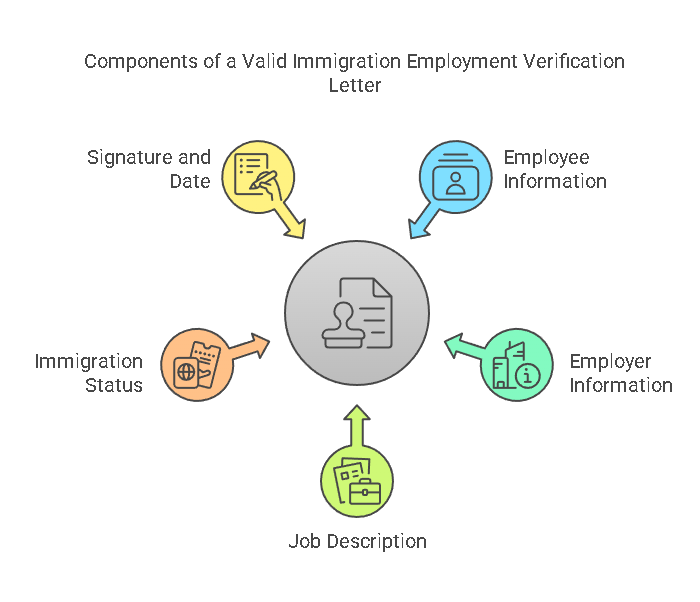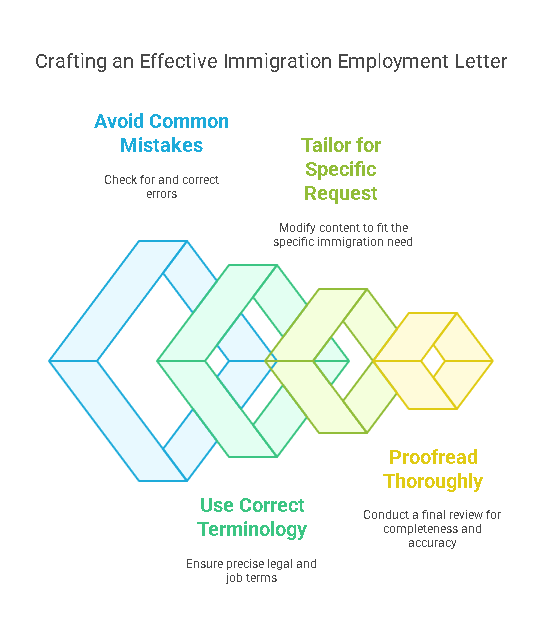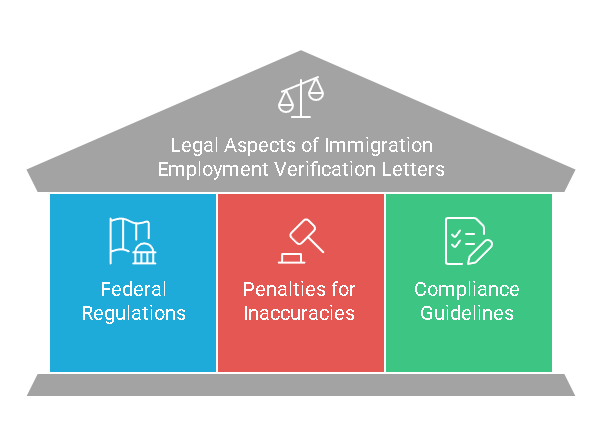The Importance of Immigration Employment Verification Letters in Visa and Green Card Applications

Immigration Employment Verification Letter: Importance, Purpose, and Key Components
An immigration employment verification letter is a critical document used in various immigration processes, especially when applying for work visas, green cards, or work permits. It verifies an employee’s current employment status with a particular company and provides essential details such as the employee’s job title, responsibilities, and immigration status. This letter serves as a bridge between employers and immigration authorities, ensuring that the employee meets the criteria for their respective immigration processes.
This letter plays a vital role in both the employer’s and the employee’s interests, ensuring compliance with immigration laws, enabling smooth processing of visa applications, and allowing individuals to maintain their legal employment status in the country.
When Is an Immigration Employment Verification Letter Needed?
An immigration employment verification letter is required in several key situations, primarily involving visa applications, green card adjustments, work permits, and immigration audits. Understanding when and why this letter is necessary helps ensure timely and efficient processing of immigration applications.
For Visa Applications: One of the most common uses of an immigration employment verification letter is for visa applications. When applying for employment-based visas such as the H1-B, L-1, or O-1 visa, the letter is crucial for proving that an applicant is employed by a company that meets the visa requirements. These employment-based visas typically require detailed documentation to ensure that the applicant is eligible to work in the specific role or industry for which the visa is being issued.
The immigration employment verification letter helps establish that the applicant’s job is consistent with the nature of the visa they are applying for. For example, the H1-B visa is reserved for individuals in specialty occupations that require highly specialized knowledge. The verification letter from the employer is an essential part of confirming that the employee fulfills this condition.
For Green Card Applications: Immigration employment verification letters are equally important in the process of applying for a green card, especially when an individual is seeking permanent residency based on employment. For instance, in employment-based green card applications, the verification letter serves as evidence that the applicant is currently employed in the job they intend to continue holding in the U.S. This letter can help confirm that the individual’s employment aligns with the green card’s qualifications and supports their application for an adjustment of status.
The letter is a critical part of the U.S. Citizenship and Immigration Services (USCIS) process, providing confirmation of the applicant’s job, salary, and role within the company. Additionally, it may be necessary to submit this letter as part of the petition to demonstrate that the applicant meets the qualifications for the specific green card category they are applying for.
For Work Permit Applications: Another scenario in which an immigration employment verification letter is required is when applying for a work permit or Employment Authorization Document (EAD). Work permits are typically issued to individuals who are authorized to work in the U.S. under temporary or specific circumstances, such as individuals with pending asylum applications or foreign nationals seeking to switch visa status.
For these individuals, submitting proof of employment helps demonstrate their eligibility for employment authorization. The verification letter can act as confirmation that the individual has been employed by a legitimate company, supporting their claim for a work permit.
In Employer Audits: During an employer audit, particularly those conducted by government agencies like USCIS or the Department of Labor (DOL), immigration employment verification letters may be required to verify that foreign workers are being employed according to the terms of their visa. These audits ensure that employers comply with immigration regulations, particularly those associated with visa programs like the H1-B and L-1.
When a company is audited, they may be asked to produce the immigration employment verification letter for any foreign workers they employ. This letter helps prove that the employee is working within the scope of their visa and that the employer is adhering to all legal obligations related to the immigration status of their employees. It can also assist in showing that the employee is being paid the proper wage and that no fraudulent activity is taking place.
Key Components of an Immigration Employment Verification Letter

For an immigration employment verification letter to be valid and effective, it must contain specific details to meet the requirements of immigration authorities. The following are the essential components that should be included in the letter:
Employee Information: The letter must include the employee’s full name, job title, and employment start date. This helps verify the identity of the employee and the length of time they have been employed at the company.
Employer Information: The company’s name, address, and contact details should be included in the letter. This establishes the legitimacy of the employer and provides a point of contact for follow-up communications.
Job Description: The letter must outline the employee’s job responsibilities, salary, and position within the company. This section provides immigration authorities with information about the role the employee is performing and whether it aligns with the type of visa they are applying for. For example, for an H1-B visa, the employer must clearly state the specialized nature of the job.
Immigration Status: One of the most important aspects of the letter is a statement regarding the employee’s immigration status. It should confirm whether the employee is a visa holder (e.g., H1-B, L-1) or a permanent resident. This helps clarify the individual’s current legal status in the country and their eligibility for further immigration benefits.
Signature and Date: The letter must be signed by an authorized representative of the employer, typically someone from the HR department or a senior executive. The date on which the letter was signed is also crucial, as it establishes the letter’s validity and ensures that the information provided is current.
Creating and Submitting an Immigration Employment Verification Letter
The process of creating and submitting an immigration employment verification letter is vital for ensuring that the letter meets both legal and procedural requirements for immigration applications. This section provides a detailed guide on how to draft, format, and submit a verification letter to relevant authorities, including USCIS and other immigration agencies. It also highlights the role of professional services like Precisehire in ensuring the accuracy and compliance of these letters.
How to Write an Immigration Employment Verification Letter
Writing an immigration employment verification letter requires careful attention to detail to ensure that all necessary information is included and presented clearly. The letter must be professional, precise, and tailored to the specific immigration process it is intended for. Below are the key steps involved in drafting a proper verification letter:
Step 1: Gather the Required Information
Before you start drafting the letter, ensure you have all the essential information from both the employee and employer. This includes:
- Employee details: Full name, job title, employment start date, and immigration status.
- Employer details: Company name, address, phone number, and point of contact.
- Employment details: A clear description of the employee’s role, job responsibilities, salary, and any special circumstances (e.g., specialized skills required for the role).
- Immigration status: Clear statement of the employee’s current immigration status (e.g., visa type, permanent residency).
Step 2: Format the Letter Properly
The letter should be written in a formal business letter format. Here’s a simple guide to formatting:
- Heading: At the top of the letter, include the employer’s name, title, and company address.
- Date: Below the heading, include the date the letter is being written.
- Recipient Information: Include the name, title, and address of the recipient, such as USCIS or other relevant immigration authorities.
- Salutation: Use formal greetings like “Dear [Title] [Last Name]” or “To Whom It May Concern.”
- Body: The body of the letter should provide the necessary information in a structured manner.
- Closing: End the letter with a formal closing such as “Sincerely,” followed by the authorized person’s signature, title, and contact information.
Step 3: Ensure Clarity and Professionalism
The letter should be concise and to the point, with no room for ambiguity. Avoid excessive technical jargon and ensure the details are clear and easy to understand. Remember, immigration officials will rely on this document to make decisions regarding visa or work permit applications, so accuracy and professionalism are critical.
Tips for Writing a Strong Immigration Employment Verification Letter

When drafting an immigration employment verification letter, consider the following tips to make sure the letter meets all expectations and legal requirements:
Avoiding Common Mistakes
One of the most important aspects of writing an immigration employment verification letter is ensuring that it is free from errors. Common mistakes include misspelling the employee’s name, listing incorrect job titles, or providing outdated information. Any inaccuracies can lead to delays in the immigration process or even cause the application to be denied.
Using Correct Terminology
Using the correct terminology related to immigration status and employment details is essential. Legal terms related to visa status (such as H1-B, L-1, or green card status) should be used accurately to avoid confusion. It is also important to describe the employee’s role and responsibilities using precise language that aligns with the immigration classification being applied for.
For instance, if the employee is applying for an H1-B visa, the letter should clearly describe how their job requires specialized knowledge or skills. If it’s a green card application, the letter should explain how the job aligns with the employer’s sponsorship of the applicant.
Tailoring the Letter for the Specific Request
Different types of immigration processes require specific details, so tailoring the letter for the exact request is essential. A letter for a work visa might emphasize different points than one for a green card application. For example, a letter for a work permit may require evidence of the employee’s work authorization and ongoing job responsibilities, while a green card letter may need to highlight the permanency and long-term nature of the employee’s position.
Proofreading
Before submitting the letter, thoroughly proofread it for any mistakes or omissions. Ensure all the required details are included, and double-check that the information is accurate and up to date. It is a good idea to have someone else review the letter to spot any errors you may have missed.
Submission of the Immigration Employment Verification Letter
Once the letter has been drafted, it must be submitted to the relevant immigration authorities. Depending on the immigration process, this could include submitting the letter to USCIS, the Department of Labor, or other government bodies overseeing immigration procedures.
Submitting to USCIS
For most visa or green card applications, the immigration employment verification letter is submitted to USCIS as part of the petition. USCIS requires this letter to verify the details of the applicant’s employment and ensure they meet the eligibility criteria for the visa or green card being applied for. The letter should be submitted along with other required documents, such as proof of employment, tax records, and pay stubs.
Other Agencies
In some cases, the letter may need to be submitted to other agencies, such as the Department of Labor or consular processing offices abroad. Each agency may have specific requirements for how the letter should be formatted and submitted, so it’s important to check the guidelines of the agency involved in the immigration process.
Role of Legal or HR Departments
Employers should ensure that the letter is signed by an authorized person from their legal or human resources department. It is also wise for the company to have legal professionals or immigration attorneys review the letter before submission to ensure compliance with all legal requirements. HR departments play a critical role in ensuring that the letter contains accurate, up-to-date information and meets all legal standards.
Precisehire’s Role in Employment Verification
Precisehire specializes in providing accurate and compliant employment verification services. For businesses and individuals navigating the immigration process, Precisehire offers expert assistance in drafting immigration employment verification letters that meet all necessary requirements. By working with Precisehire, employers can ensure that their verification letters are accurate, complete, and tailored to the specific needs of the visa or work permit application.
Precisehire’s services extend beyond just writing letters. The company helps employers streamline their immigration processes by ensuring that all necessary documentation, including employment verification, is submitted in a timely and efficient manner. This reduces the risk of delays or denials and ensures that both employers and employees remain compliant with immigration regulations.
Legal Aspects of Immigration Employment Verification Letters

Immigration employment verification letters are not just a formality; they are legally binding documents that must adhere to federal and immigration regulations. Understanding the legal aspects of these letters is crucial for both employers and employees to ensure compliance and avoid any legal pitfalls. In this section, we’ll discuss the legal requirements, penalties for inaccuracies, and how to navigate the complexities of immigration employment verification.
Federal Regulations and Legal Requirements
When creating and submitting an immigration employment verification letter, it is essential to understand the federal regulations governing employment verification. These regulations are in place to ensure that all parties involved in the immigration process follow legal and ethical guidelines. Here are the key federal regulations that affect immigration employment verification letters:
- Immigration and Nationality Act (INA): The INA outlines the eligibility requirements for foreign nationals to work in the United States. This law requires employers to verify the employment status of individuals applying for visas or other work authorizations. Immigration employment verification letters must be consistent with this law and provide accurate information regarding the employee’s position and visa status.
- Form I-9 and E-Verify: While Form I-9 is used to verify the identity and employment eligibility of individuals hired in the United States, immigration employment verification letters supplement this form when submitting visa or green card applications. The E-Verify system may also be used to verify the employment status of an employee through an electronic process.
- Department of Labor (DOL) and USCIS Guidelines: The U.S. Department of Labor and U.S. Citizenship and Immigration Services (USCIS) have specific guidelines for employment verification letters. For instance, the DOL oversees employment-based visa petitions, and USCIS ensures that employers follow the rules for immigration sponsorship. Both agencies may require verification letters as part of the petition process.
Penalties for Inaccuracies or Fraudulent Letters
Submitting inaccurate or fraudulent immigration employment verification letters can have severe consequences for both employers and employees. The penalties for inaccuracies can range from delays in the immigration process to legal consequences. These include:
- Delays or Denials in Visa or Green Card Applications: If an immigration employment verification letter contains incorrect information, such as incorrect job titles, salaries, or work responsibilities, the application could be delayed or denied. USCIS and other immigration agencies rely on these letters to assess an applicant’s eligibility, so any discrepancies can significantly affect the approval process.
- Penalties for Employers: Employers who submit false or misleading verification letters can face legal consequences, including fines and penalties. In severe cases, employers could be subject to an audit or investigation by immigration authorities. Employers may also face penalties under the INA for knowingly providing false employment information.
- Penalties for Employees: If employees knowingly provide false information or allow their employers to submit inaccurate employment verification letters, they may face consequences such as denial of immigration benefits, deportation, or future visa restrictions. Providing fraudulent documents can lead to criminal charges, including visa fraud and identity theft.
- Criminal Liability: In cases of intentional fraud, both employers and employees could face criminal charges. Immigration fraud is a serious offense, and any attempt to manipulate or falsify immigration documents, including employment verification letters, can lead to severe penalties, including imprisonment.
FAQs
Here, we’ll address some common questions related to immigration employment verification letters and their legal implications.
1. What Is the Difference Between an Immigration Employment Verification Letter and a Standard Employment Verification Letter?
What Is the Difference Between an Immigration Employment Verification Letter and a Standard Employment Verification Letter?
An immigration employment verification letter is specifically tailored for immigration purposes, including visa applications, green card processes, and work permits. Unlike a standard employment verification letter, which generally confirms employment details for purposes like loans or rental applications, an immigration verification letter must include specific immigration status information and align with the legal requirements of the immigration process.
Can I Use an Employment Verification Letter for Both Visa and Work Permit Applications?
Yes, an employment verification letter can be used for both visa and work permit applications, but it must be tailored to the specific requirements of each application. For example, a letter for an H-1B visa will highlight the employee’s qualifications for a specialty occupation, while a work permit letter may focus more on confirming employment status and job responsibilities.
How Long Does the Immigration Employment Verification Letter Remain Valid?
The validity of an immigration employment verification letter can vary depending on the immigration process. For most visa applications, the letter is valid for the duration of the application process. However, if the application is delayed or the employee’s status changes, the letter may need to be updated to reflect the new circumstances.
What If I Don’t Have an Employment Verification Letter From My Employer?
If you do not have an employment verification letter from your employer, it may cause significant delays or complications in your immigration process. It is essential to request the letter from your HR department or directly from your employer. If your employer is unwilling to provide it, you may want to seek legal advice or work with an immigration attorney to find alternative ways to verify your employment status.
How Can Precisehire Help Me With Immigration Employment Verification Letters?
Precisehire offers specialized services to help both employers and employees navigate the complexities of immigration employment verification. By partnering with Precisehire, employers can ensure that their verification letters meet legal standards, reducing the risk of delays or denials. Precisehire’s expert services also help ensure that the correct terminology and information are included, minimizing the chances of errors and ensuring compliance with all applicable immigration laws.
Conclusion
Immigration employment verification letters are essential for individuals seeking employment-based immigration benefits, including work visas and green cards. These letters must be accurate, comprehensive, and aligned with both legal requirements and the specific needs of the immigration process. Employers must ensure that the information provided in these letters is truthful, as inaccuracies can lead to penalties, delays, or denials of applications.
To ensure that immigration employment verification letters are drafted and submitted correctly, working with professionals such as Precisehire can be invaluable. Precisehire helps employers and employees navigate the complexities of immigration verification, ensuring compliance with immigration laws and increasing the likelihood of a successful immigration application.
